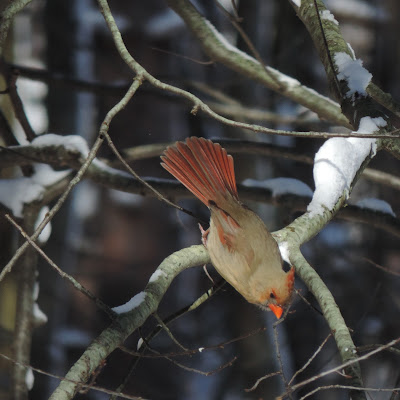Another flowering plant that you see quite frequently indoors this time of year is the Amaryllis. You can pot this bulb up in late fall and usually by Christmas or January you have large blooms to brighten up your living space. This is another plant(bulb) that would not survive our winters. I either pot mine up in late spring or plant them right in the ground when it warms up (but then the bulb has to be dug up in the fall).
| Another variety of Amaryllis |
 |
| Another variety of Amaryllis. Photo courtesy of Nancy Ethier Carrod. |
The picture below of a Freesia (although not very red) was a surprise to me. I purchased this plant when it was blooming last spring. I planted it directly in the ground because I thought it would rebloom after the initial one, but it never did. I really didn't know much about them, but the flower was very graceful looking and the colors were nice and bright. In late summer the plant died completely back and I thought it just died out. But a few months later when I was cleaning out the garden for fall I noticed that this plant had started sending up new shoots. So after I read up on it a little, I found out that this bulb would not survive our winters either. So I dug these bulbs up and potted them up. I also have a purple one that opened its first bloom today. I think what I might do next fall after they die back, dig them up and not re-pot them, but plant them outside in the spring. Then they should flower later in the summer. The foliage is rather strappy and has to be staked which is not very attractive, but the flowers make up for it.
And is there any other bird that looks more beautiful against a snowy backdrop than the Northern Cardinal?
 |
| Female Northern Cardinal |
The picture below is of a male Pileated Woodpecker. It's native to North America and found around the Great Lakes and Canada in deciduous forests. It's male identifying characteristics would be the red moustache from the beak and the red on the top of his head that extends to the beak. The female would have a black moustache and the red on top of the head would not extend that far down the front of the face. They drill large holes with their beak on dead trees in search of ants and bugs.
My husband got the great capture of Robins in our side yard last week. There was a very large flock of Robins that flew in and they were here most of the afternoon drinking from the exposed water areas of the ditches and run-off. We usually don't see Robins in this area until the end of March so we're thinking that maybe the Punxsutawney Phil Groundhog was wrong this year and we'll have an early spring.
| Sumac against the winter gray sky. |
And what a surprise it was last spring to find out that we had a den of Red Foxes (babies are called kits, cubs, or pups) living under our shed. We thought something was living under there, but we were thinking maybe it was a raccoon or possum. So my husband set up the trail camera in the area to find out what it was and this showed up.
"All you need is love.
But a little chocolate now
and then doesn't hurt."
~ Charles M. Schultz
Feel free to leave a comment ~